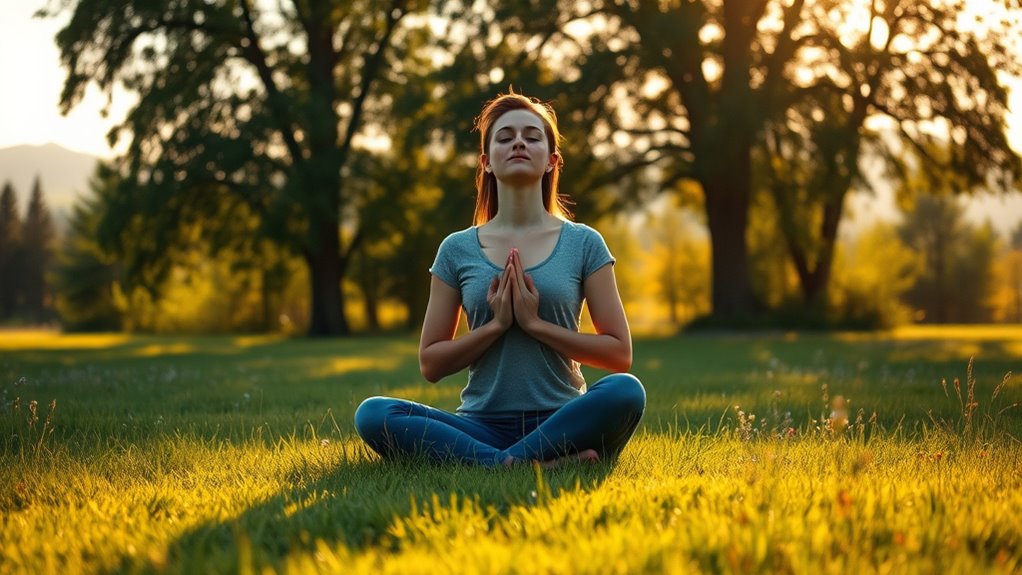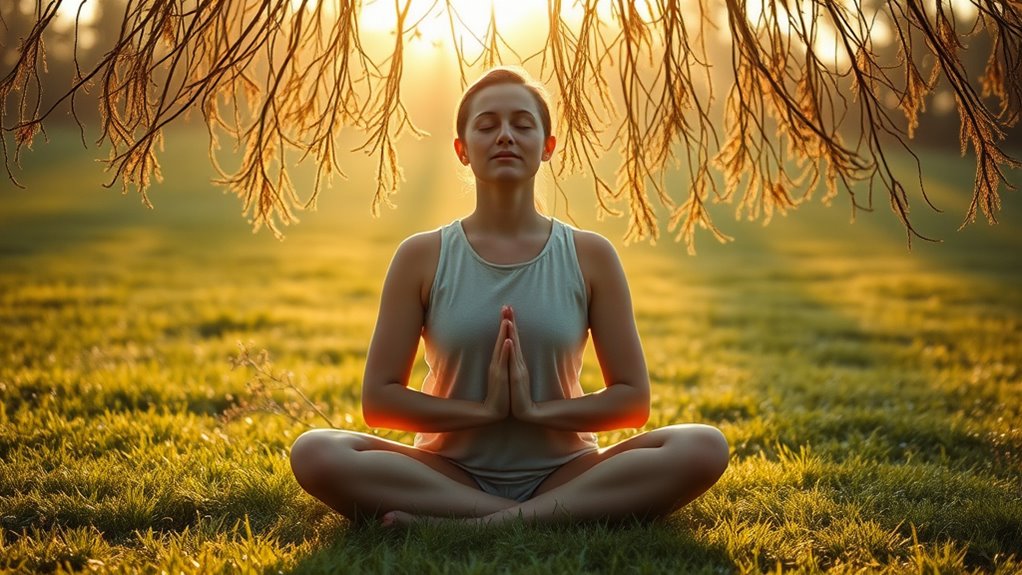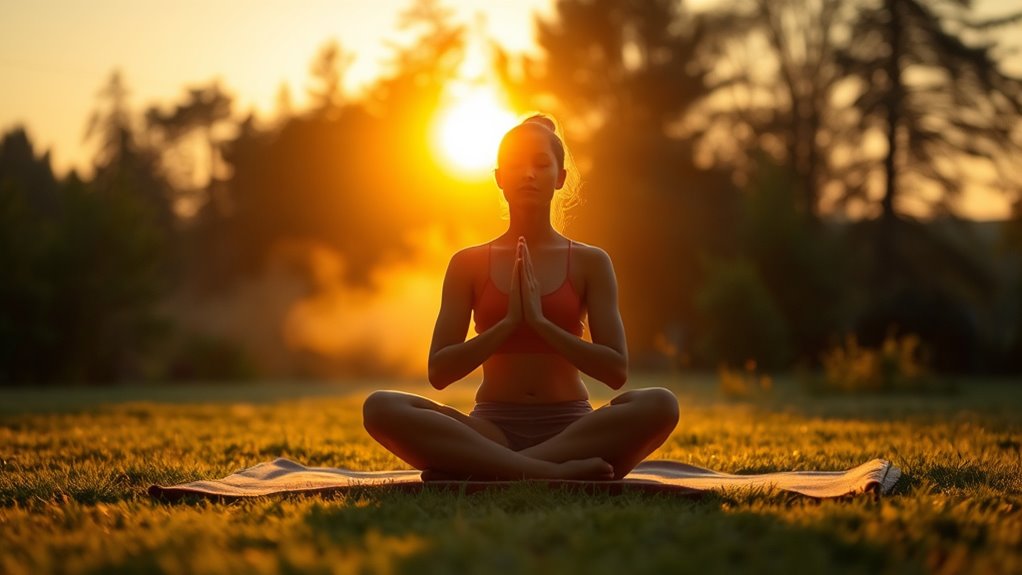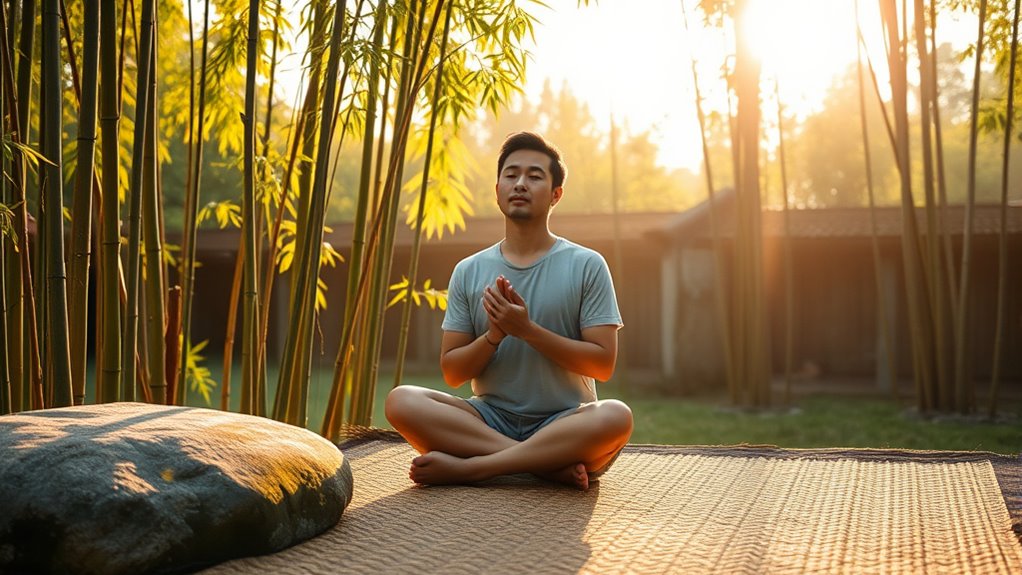Starting your day with four intentional breaths helps you establish calmness and focus right from the moment you wake. By pausing to breathe deeply, you signal your mind and body to settle, setting a mindful tone before your busy schedule begins. Each breath anchors you in the present, reducing stress and increasing clarity. Keep practicing this simple ritual consistently, and you’ll discover how these four breaths can transform your mornings—and there’s more to uncover if you continue exploring.
Key Takeaways
- Four intentional breaths anchor attention, creating a calm and focused mental state at the start of the day.
- This breathing pattern interrupts distractions, helping to reset and set a purposeful tone for the morning.
- Focused inhaling and exhaling activate the parasympathetic nervous system, reducing stress and fostering relaxation.
- Each breath can be paired with positive intentions or gratitude, shaping a mindful and optimistic mindset.
- Consistently practicing four breaths establishes a daily rhythm of mindfulness, grounding the mind before daily activities begin.
The Power of a Morning Pause

Starting your day with a deliberate pause can set a powerful tone for everything that follows. When you take a few moments for mindful mornings, you create space for clarity and calm before your busy day begins. Incorporating a simple morning ritual, like deep breathing or stretching, helps anchor your mind and body. This intentional pause allows you to reset, focus, and approach your day with purpose. Instead of rushing through your routines, slow down and savor these moments. The power of a morning pause lies in its ability to ground you, encouraging mindfulness early on. With consistent practice, these small, intentional actions become a foundation for greater awareness and emotional resilience throughout your day.
Why Four Breaths Make a Difference

Taking just four intentional breaths can markedly enhance your mindfulness and overall sense of calm. The precise breath timing helps anchor your attention, creating a deliberate pause that interrupts daily distractions. With each inhale and exhale, your mind shifts from clutter to clarity, sharpening mental focus. This simple practice activates your parasympathetic nervous system, reducing stress and promoting relaxation. Four breaths are enough to reset your mental state, making you more present and aware. It’s a small but powerful act that sets the tone for your day, allowing you to approach each moment with greater clarity and intention. By consistently practicing this, you’ll find it easier to stay centered and mindful, even amid life’s chaos. Incorporating mindfulness techniques into your routine can deepen these benefits over time.
Setting Your Intention With Each Breath

As you breathe intentionally, you have the opportunity to direct your mind toward a specific purpose or feeling. Setting an intention with each breath anchors your awareness and deepens your practice. You might focus on gratitude, acknowledging what you’re thankful for, or incorporate mindful journaling afterward to reflect on your experience. Consider this table to guide your intentions:
| Breath | Intention Focus | Suggested Practice |
|---|---|---|
| 1st | Cultivate gratitude | Think of something you’re grateful for |
| 2nd | Foster calmness | Breathe in peace, breathe out tension |
| 3rd | Enhance presence | Be fully present in this moment |
| 4th | Set a positive tone | Visualize a positive outcome |
Additionally, practicing mindfulness during this process can help deepen your awareness and enhance the benefits of your meditation.
Creating Space for Calmness

Start by finding a quiet spot where you won’t be disturbed, allowing your mind to settle. Set a gentle intention to create space for calmness, and then focus on your breath, noticing each inhale and exhale. This simple practice helps you cultivate a peaceful environment inside yourself. Incorporating mindfulness techniques such as deep breathing exercises can further enhance your focus and relaxation.
Find a Quiet Spot
Finding a quiet spot is essential for creating the calm environment needed for meditation. Look for a place where noise won’t interrupt your focus, perhaps near windows with soft natural light or a cozy corner away from distractions. Nature sounds, like gentle breezes or birdsong, can enhance this peaceful atmosphere, helping you relax more deeply. Choose a spot where you feel safe and comfortable, free from clutter or interruptions. This dedicated space signals your mind that it’s time to settle down and be present. Whether it’s a corner in your living room or a quiet nook outdoors, making this intentional choice sets the foundation for a mindful meditation. The right environment makes it easier to focus and truly connect with each breath. Creating an environment that embraces rustic decor and natural textures can further promote tranquility.
Set a Gentle Intention
Setting a gentle intention before you begin meditation helps create a calm and focused mindset. Take a moment to reflect on what you’re grateful for, practicing mindful gratitude to anchor yourself in the present. Softly repeat gentle affirmations like “I am open to peace” or “This time is for my well-being.” These small acts foster a sense of kindness toward yourself and set a positive tone for your practice. By consciously choosing a gentle intention, you create space for calmness to unfold naturally. This mindful approach encourages patience and openness, allowing you to let go of stress and distractions. Incorporating meditation techniques can further enhance your ability to cultivate stillness and clarity. With clarity and compassion, you prepare your mind to deepen your meditation and embrace the stillness ahead.
Focus on Your Breath
Focusing on your breath helps create a natural space for calmness to unfold. By cultivating breath awareness, you tune into the subtle rhythm of your inhalation and exhalation. This simple shift grounds you in the present moment. To deepen this focus:
- Observe your inhalation, noticing its length and quality.
- Follow the rhythm of your exhalation, allowing it to slow naturally.
- Maintain gentle attention, avoiding control or force.
- Incorporate mindful awareness of breath control, understanding how subtle adjustments can enhance your sense of tranquility.
Grounding Yourself in the Present Moment

To ground yourself in the present moment, start by focusing on your breath, feeling each inhale and exhale. Pay attention to how your body feels as you stay still, anchoring your awareness. Embrace stillness, letting it deepen your connection to now. Being aware of your surroundings can also enhance your sense of grounding and presence.
Focus on Breath
Taking a moment to focus on your breath can instantly anchor you in the present. By practicing mindful breathing, you heighten your sensory awareness and ground yourself amidst distractions. To deepen this focus:
- Notice the sensation of each inhale and exhale, feeling the air move through your nose or mouth.
- Observe how your chest or belly rises and falls with each breath.
- Gently bring your attention back whenever your mind wanders, without judgment.
- Regular cleaning and maintenance of your breathing space can enhance your overall sense of calm and clarity, similar to how proper maintenance and troubleshooting of equipment ensures optimal performance.
This simple practice helps you stay present, calm, and centered. Concentrating on your breath creates a natural pause, allowing you to reconnect with the here and now. With consistent practice, this focus on breath becomes a powerful tool for mindfulness.
Feel Your Body
Feeling your body directly connects you to the present moment and anchors your awareness in the here and now. Pay close attention to your body awareness by noticing physical sensations without judgment. Feel the contact points where your body touches the surface beneath you, whether it’s your feet on the ground or your back against a chair. Notice the subtle movements, tension, or relaxation in different areas. Focus on the sensations of warmth, coolness, pressure, or tingling. By tuning into these physical sensations, you ground yourself in the now, grounding your mind and body together. This simple practice helps you stay present, clear your mind of distractions, and deepen your meditation experience. Feel your body fully, and let it serve as your anchor. Practicing mindfulness in this way enhances your ability to cultivate calm confidence throughout your day.
Embrace Stillness
Embracing stillness means intentionally settling your mind and body into a state of calm awareness. It’s about grounding yourself in the present moment, especially during mindful mornings. To cultivate this, try these simple steps:
- Start your day with a few deep, intentional breaths, allowing your thoughts to settle.
- Focus on your surroundings—notice the sensations, sounds, and smells during your morning routines.
- Take a moment of silence before jumping into your busy schedule, centering yourself in the here and now. Incorporating a calibration of your breathing can enhance your sense of balance and focus.
Incorporating First-Light Meditation Into Your Routine

To seamlessly incorporate First-Light Meditation into your daily routine, start by choosing a consistent time each morning, ideally at dawn when the world is quiet and still. This sets the stage for mindful mornings, helping you begin each day with intention. Create a dedicated space where you can sit comfortably without distractions. Begin with your breath awareness, taking slow, deliberate breaths as you settle into the moment. Focus on the four breaths that set the tone, allowing your mind to anchor in the present. As these breaths become a natural part of your morning, you’ll find it easier to carry mindfulness throughout the day. Consistency is key—over time, this practice will become a essential part of your daily rhythm.
Overcoming Common Challenges

Even with the best intentions, you might find it challenging to stay focused during First-Light Meditation, especially when distractions or restless thoughts arise. To overcome these hurdles, try these strategies:
- Manage distractions by gently redirecting your attention back to your breath without judgment.
- Build consistency by setting a specific time each morning, making meditation a non-negotiable part of your routine.
- Address restless thoughts by observing them without attachment, allowing them to pass naturally.
Extending the Calm Beyond Your Morning

Once you’ve established a peaceful morning meditation routine, the next step is to carry that sense of calm into your day. Using mindfulness techniques throughout your daily activities helps reinforce the meditation benefits, keeping you centered and focused. Simple practices, like mindful breathing during breaks or paying full attention while eating, extend your calm state beyond the mornings. These techniques cultivate awareness and reduce stress, allowing you to respond thoughtfully rather than react impulsively. Incorporating moments of mindfulness into your routine creates a continuous thread of tranquility, making it easier to navigate challenges with clarity. By consciously extending your calm, you deepen the effects of your meditation, fostering a sustained sense of peace that benefits your mental and emotional well-being all day long.
Embracing Minimalism in Mindfulness Practices

Embracing minimalism in your mindfulness practices means simplifying your routines to focus on what truly matters. By practicing mindful minimalism, you remove distractions and cultivate intentional simplicity. To get started:
- Limit your meditation to a few focused breaths rather than lengthy sessions, emphasizing quality over quantity.
- Remove clutter from your environment to create a calm, distraction-free space that encourages presence.
- Prioritize essential techniques like breath awareness or body scans, avoiding overwhelming yourself with multiple methods.
This approach helps you cultivate clarity and deepen your connection to the present moment. When you embrace this intentional simplicity, mindfulness becomes effortless rather than burdensome, making every moment more meaningful. Minimalism becomes a tool to sharpen your focus and nurture inner peace.
Frequently Asked Questions
How Long Should Each Meditation Session Last for Optimal Benefits?
When considering session length for meditation, you should follow duration guidelines that suit your schedule and goals. Typically, a session lasting 10 to 20 minutes offers substantial benefits, allowing you to deepen your practice without feeling overwhelmed. Shorter sessions of 5 minutes can still be effective, especially for beginners. The key is consistency, so choose a duration that you can maintain regularly to maximize your meditation’s positive impact.
Can First-Light Meditation Be Practiced in Any Environment?
Some might think meditation requires a quiet, controlled space, but first-light meditation offers environment flexibility. You can practice outdoors or in busy settings without losing focus, making it perfect for busy mornings. The key is to find a peaceful moment, even in chaos. Outdoor meditations or any environment that allows you to connect with nature and your breath help set a calming tone for the day.
What if I Forget to Do the Four Breaths in the Morning?
If you forget to do the four breaths in the morning, don’t worry—it’s normal. Your morning routine should support habit consistency, so if this step slips your mind, simply pick it up later in the day. Consistency matters more than perfection. Incorporate the four breaths whenever you remember, and over time, it’ll become a natural part of your routine, helping you start each day with calm and focus.
How Does First-Light Meditation Impact Long-Term Mental Health?
Even small shifts in your routine can quietly boost your mental health over time. First-light meditation fosters mindfulness benefits like increased emotional resilience and clarity. It helps you start the day with intention, setting a positive tone. While missing a session isn’t a setback, regularly practicing can strengthen your mind’s resilience, encouraging a calmer, more centered outlook. Over time, these gentle habits nurture lasting emotional well-being.
Is It Necessary to Meditate at the Same Time Every Morning?
You don’t need to meditate at the same time every morning, but maintaining timing consistency helps create a reliable morning ritual. When you stick to a regular schedule, it becomes easier to incorporate meditation into your daily routine and enjoy its benefits. Flexibility is okay if your mornings vary; just aim for consistency over perfection. Ultimately, regular practice, whether at the same time or not, supports your mental well-being.
Conclusion
By starting your day with just four mindful breaths, you set the tone like a gentle sunrise, illuminating your entire day. This simple act creates a ripple effect, anchoring you in calm amidst life’s chaos. Embrace this minimalist moment of clarity, knowing that even the tiniest pause can bloom into a haven of peace. Make this your daily ritual, and watch as your mornings transform from busy storms into tranquil dawns.










